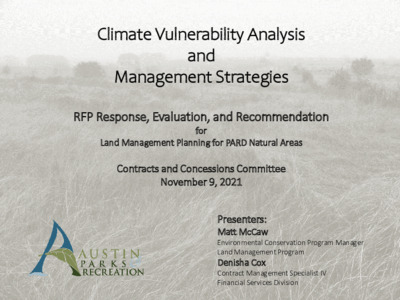B1: Presentation — original pdf
Backup

Climate Vulnerability Analysis and Management Strategies RFP Response, Evaluation, and Recommendation for Land Management Planning for PARD Natural Areas Contracts and Concessions Committee November 9, 2021 Presenters: Matt McCaw Environmental Conservation Program Manager Land Management Program Denisha Cox Contract Management Specialist IV Financial Services Division 2 Background: Recreation opportunities • • mental health benefits • • • water cleansing air cleansing • social benefits climate regulation • • • • • A natural area is an area that retains or has reestablished its natural character, typically dominated by native plants and animals. The majority of PARD’s ~ 17,000 acres of land are protected as natural areas in preserves, greenbelts, metro parks, district parks, and even along the margins of golf courses. These natural areas provide critical services, such as • Most have not been managed to maintain ecosystem health. • They are threatened by climate change, invasive species, and loss of biodiversity, all of which make them more susceptible to heat, drought, disease, and wildfire. The need for comprehensive planning and management of PARD natural areas has long been recognized by staff, partners, and the community. The 2019 Wildfire Preparedness Audit highlighted this need from a public safety standpoint. • • Recommended that PARD create and implement land management plans. PARD committed to establish a land management team to do this. 3 Background: • City Council recently adopted the Austin Climate Equity Plan and directed staff to implement the plan, including: • defining leadership responsibilities identifying related items for budget amendment • • prioritizing strategies that support multiple plan goals • This land management plan helps to address the following Natural Systems goals in the Climate Equity Plan: resilience. • Goal 1: By 2030, manage all new and existing natural areas with a focus on • Goal 3: Achieve at least 50% citywide tree canopy cover by 2050. • Goal 4: By 2030, include all City-owned lands under a management plan that results in neutral or negative carbon emissions and maximizes community co- benefits. Deliverables & Plan Components 4 Restoration strategies that may be effective and appropriate for achieving management goals in various contexts. Monitoring design to evaluate progression toward management goals. ~10-year document; 50-year horizon. Site analysis • Soils • Hydrology • Existing vegetation communities • Endangered species habitat • Trails, authorized and unauthorized • Other elements Climate vulnerability analysis • Identify components of ecosystems that affect vulnerability to intense heat, drought, and wildfire • Map these components to indicate where natural resources may be most vulnerable to climate change • Will help prioritize work Management goals: Vegetation communities that are expected to provide desired ecosystem services most sustainably. Solicitation Timeline 5 • RFP Published • Pre-Proposal Meeting • RFP Close Date • RFP Evaluation • 3 proposals received • 1 deemed non-responsive • Recommendation to Re-Bid • Re-Bid RFP Published • Pre-Proposal Meeting • RFP Close Date • RFP Evaluation • 3 proposals received • 0 deemed non-responsive 02/01/2021 02/09/2021 03/04/2021 03/25/2021 07/26/2021 08/03/2021 08/24/2021 09/16/2021 • Recommended Awardee Posted on Austin Finance Online 10/05/2021 6 RFP Evaluation and Point Allocation Max Points: 20 Evaluation Criteria: Operational Planning Q&E: Climate resiliency planning for natural systems, particularly in semiarid or subhumid forest or woodland. Q&E: Experience with woodland or forest health management, particularly in semiarid or sub-humid climates. Q&E: Implementing large ecological restoration projects, particularly in semiarid or subhumid grassland and woodland. Q&E: Writing land or resource management plans for public agencies and/or large organizations. Q&E: Experience planning and implementing prescribed burns. Q&E: Publication of relevant original research or literature analyses in peer- reviewed journals. Ecological data analysis. Ecological monitoring. Price Local Business Presence SDVBE Total: 15 13 8 8 5 8 10 10 3 100 Evaluation Matrix 7 8 Requested Committee Action: Make a recommendation to the Parks and Recreation Board to recommend to City Council to authorize the negotiation and execution of an agreement with the successful proposer, Ecosystem Design Group, LLC, for land management planning for Department natural areas.